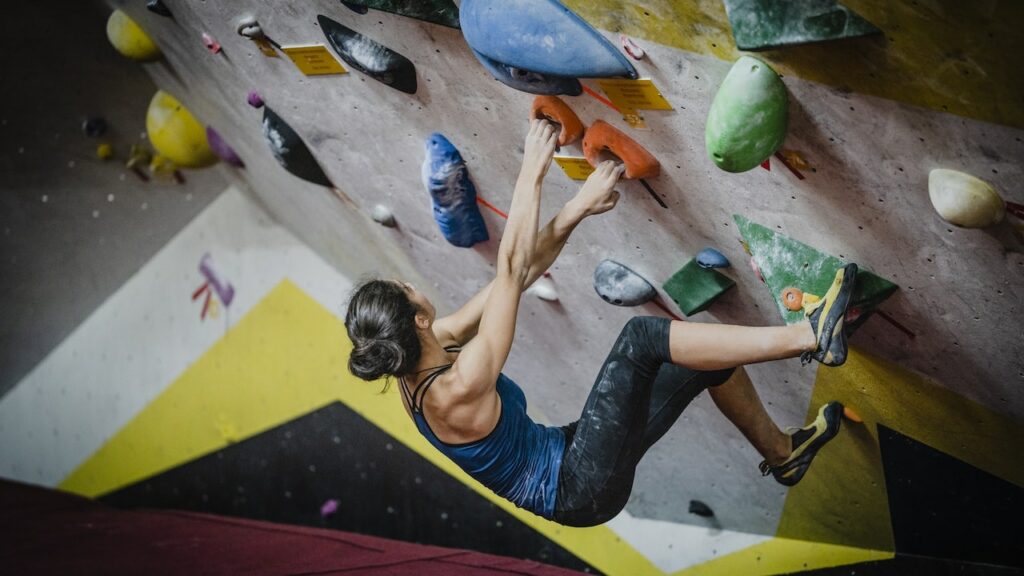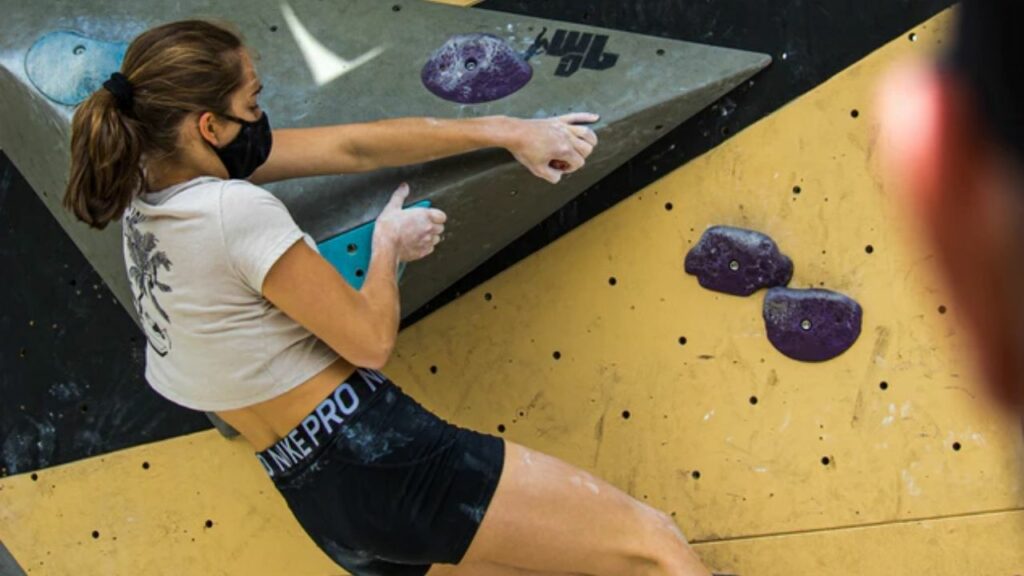I don’t know about you, but I find the idea of working out at the gym – repeating the same sets of exercises every week – inherently dull.
But I love rock climbing and have been on the rocks for over a decade now. And it potentially eliminates the necessity of going to a gym or exercising at a health club. Rock climbing isn’t called “the ultimate full-body workout” for nothing.
Many people think rock climbing and bouldering are just fun sports and that you still have to go to the gym to remain in shape. And then there are those who think the fun of rock climbing isn’t worth the risk because of the “strain” it puts on your body.
Truth is, neither of those opinions are 100% accurate. So, what exactly does rock climbing do to your body? Let’s find out – the good, the bad, and the final verdict.
The Good: What does rock climbing do to your body?
Firstly, I’m gonna be talking about indoor rock climbing and indoor bouldering in this guide. Sure, you’ll still work the same muscles while climbing outdoors, but climbing at the gym is safer. It’s a better option for people interested in the “exercising” aspect of climbing.
According to WebMD, “rock climbing is an excellent workout, but it can be rough if your body isn’t up for it.” This is because exercise, in general, is just about working your muscles – tearing them down with strenuous tasks and building them back up stronger.
1. Which muscles does rock climbing work?
Rock climbing works the entire musculature of your body through dynamic movement. It works your core, upper body muscles (forearm flexors, rhomboids, latissimus dorsi, anterior deltoid), and lower body muscles (quadriceps, calf muscles).
You know that everything in climbing starts with the grip of your fingers. That’s what keeps you elevated and floating mid-air on such tiny cracks and crevices. The caveat though is that our fingers have no muscles whatsoever, so the finger grips are actually powered by the flexor muscles in your forearm.
Our fingers have multiple ligaments and tendons. The flexor muscles work by contracting tendons that contract the ligaments tightly to create the “grip.” This pseudo pulley and lever system made by muscles, tendons, and ligaments is extensively worked upon during climbing.
Hence why finger injuries are common among climbers and why you should be intentional when exercising and get proper rest so your body can recover.
Your upper body goes through massive amounts of changes when you step into the world of climbing. Like your forearm flexors, climbing would put pressure on your shoulder retractors (rhomboids), latissimus dorsi (large muscles on the side of your back), and anterior deltoid (shoulder muscles). As you climb, you’ll keep these muscles contracted and produce more and more lactate every time you climb.
After fingers, your core – specifically the abdominal muscles – get worked the most. This constant state of contraction stabilizes your center of gravity by aligning with your pelvic muscles at all times.
Similarly, the pressure and muscle contraction will help build your lower body by tearing down and rebuilding your leg muscles – quadriceps (thighs), soleus and gastrocnemius (calves), and the tendons on your toes.
2. Can rock climbing build muscle?
Rock climbing and bouldering can help build muscle thanks to the dynamic muscle movement you experience when climbing off the wall. Climbing also produces more lactate in your arms than standard gym exercises. Lactate helps build the “growth hormone” and thus the muscle itself.
When you rock climb for an extended period or on a longer route, your arms are compressed all the time because of the finger grip. This compression squeezes your capillaries to get as much blood out as possible for the grip to keep working.
After you reach your threshold, the capillaries get squashed, cutting off the blood supply. This produces lactate, making the arm numb and causing a pinching pain in the forearms.
Regularly crossing this lactate threshold will help build stamina, endurance, and muscles. It’s called “lactic acid training.”
3. Can rock climbing help you lose weight & get you in shape?
Let me be clear, rock climbing can absolutely help you lose weight and get in shape thanks to dynamic movement.
I’ve used the term “dynamic movement” a few times now, but what does it actually mean? Let’s find out.
A. Can rock climbing gyms replace the traditional gym?
Rock climbing can replace your daily gym workouts or health club visits quite easily. Climbing and bouldering are frankly unrivaled in working the most diverse set of muscles without repetition. That’s why rock climbing would provide better results than a standard gym.
At a gym, you’d assign each day of the week to exercise a specific body part such as biceps and triceps to properly focus on all the muscles.
Then the idea is to keep increasing the intensity as your muscles grow stronger and adapt to the repetitive exercises. You don’t have to worry about any of that with rock climbing because each climbing route is subtly different from others.

You can even use different steps to send the exact same route. In short, your muscles will grow stronger throughout the body and hit the growth plateau more efficiently because of the lack of repetition.
Many independent researchers have concluded that these kinds of dynamic (non-repetitive) exercises and movements activate a more extensive set of muscles and are more challenging than repetitive exercises.
So essentially, you’ll burn more calories climbing than you would be doing a standard workout at a traditional gym.
B. Can rock climbing get you ripped?
When paired with proper diet and training, rock climbing can get you ripped and help develop a toned set of abs. Your abdominal muscles are in a constant state of contraction when climbing, which works them out like crazy.
In other words, you can get chiseled from rock climbing, but 6-pack abs demand a lot more than just a single activity. You’ll need to take extra steps to get that set of abs you’ve always wanted.
The Bad: What does rock climbing do to your body?
We’ve discussed a lot about the benefits of rock climbing and how it affects our body’s musculature. Now, let’s look at the bad.
The two most common questions that I’m always asked regarding the dangers of rock climbing are arthritis and carpal tunnel.
1. Can rock climbing cause arthritis?
Many people just starting climbing have fears of getting osteoarthritis rather than arthritis. Osteoarthritis is a condition caused by wear and tear of joints from normal aging or intensive workout, while arthritis is a mechanical condition independent of “wearing.”
Rock climbing and bouldering can neither cause arthritis nor osteoarthritis. Repetitive climbing injuries can result in osteoarthritis, as true for any other sport. A 2006 study confirmed that climbers aren’t at an increased risk of osteoarthritis compared to non-climbers.
In the study, researchers from the University of Washington, University of Tennessee, and the FBI Laboratory examined samples of Southeastern climbers who climbed from 5.9 to 5.14b sport and from V1 to V12 at the boulders.

There’s a surprising twist though…
Rock climbing and bouldering are actually excellent for arthritis patients. This has been confirmed by many research studies as well as real-life examples of people who self-cured their arthritis through climbing. Modern physicians have started prescribing climbing to their patients.
2. Can rock climbing cause carpal tunnel?
Carpal tunnel is a condition that results in weakness or even numbness in the thumbs and fingers.
Rock climbing can result in a carpal tunnel, but so can typing on a computer keyboard all day because of the repetitive movements in both activities. And even then, some people are more prone to developing carpal tunnel than others.
Basically, don’t worry too much about it as long as you’re listening to your trainer and getting proper guidance.
3. Muscular Imbalance
Do you remember the so-called dynamic movement we talked about earlier? Well, it has one teeny-tiny flaw – while it does cover your entire primary musculature, it doesn’t work on 100% of the muscles in your body.
People who do climbing-only training without proper guidance and additional exercises suffer from muscular imbalance where certain muscles remain underdeveloped while the body grows.
Prevention: Get a training chart from your climbing gym trainer, and don’t skip out on non-climbing exercises.
What’s the verdict: good or bad?
Rock climbing is an excellent sport – the rate at which it develops your whole body while you’re outside living life is unrivaled.
There are pros and cons that come with everything including gym workouts, but risk prevention for climbers is relatively straightforward if you follow advice from your trainer and other experts.
Still, with all the positive changes that rock climbing has on your body, it’s safe to say it can replace the gym for most people.

